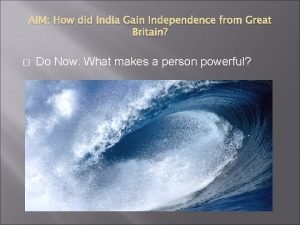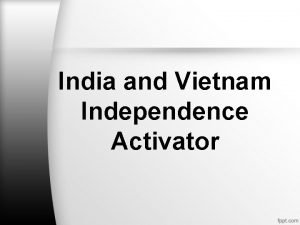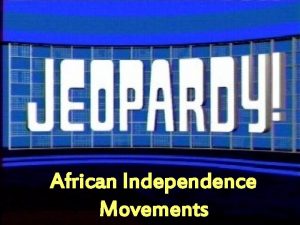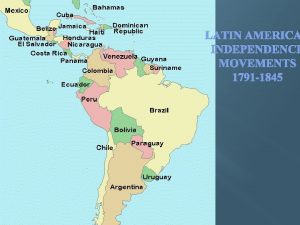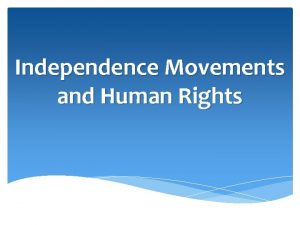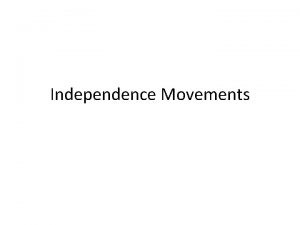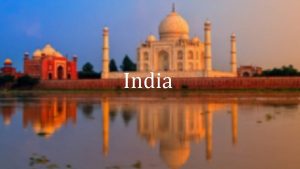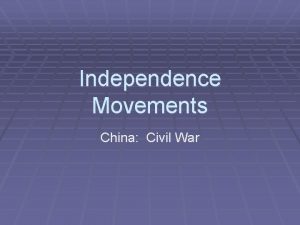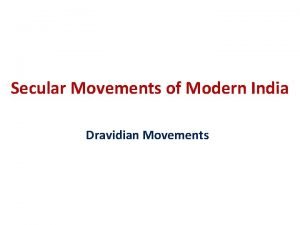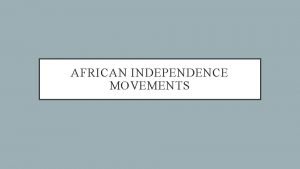Independence Movements Independence in India World War I













- Slides: 13

Independence Movements Independence in India

World War I Heightens Nationalist Activity n n n Prior to World War I, Indians had little interest in self-rule or independence When World War I began, the British promised India reforms that would eventually lead to selfgovernment (provided at least a million Indian soldiers) 1918 – Great Britain had no desire to give India independence (self-rule) – many Indians revolted

World War I Heightens Nationalist Activity 1919 – Great Britain passed the Rowlatt Act – allowed the government to jail protestors without trial for as long as two years (denial of trial by jury) – more violence erupted n Amritsar Massacre – British soldiers fired on Hindus and Muslims who had gathered to protest the Rowlatt Act – Indians demanded independence from Great Britain Armistar Massacre n

Gandhi’s Principle of Nonviolence n n n Mohandas K. Gandhi – leader of India’s independence movement Promoted use of civil disobedience – the deliberate and public refusal to obey an unjust law Gandhi called on Indians to refuse to do the following – buy British goods, attend government schools, pay British taxes, and vote in elections

Gandhi’s Principle of Nonviolence n n n Encouraged Indians to weave their own cloth and boycott British cloth (a huge source of wealth for the British) Salt Acts – Indians could buy salt from no other source but the government (they also had to pay taxes on salt) Salt March – Gandhi and his followers walked 240 miles to the seacoast to get their own salt



Gandhi’s Principle of Nonviolence n n Police officers attacked defenseless marchers outside a salt plant (a place where the British government process salt) – world journalists reported the violence against unarmed and nonviolent Indians 1935 – Great Britain passed the Government of India Act (provided for local self-government and limited democratic elections)

Religious Tensions 1947 – India gained independence from Great Britain n Sri-Lanka-formerly known as Ceylon gained its independence n Religious differences led to the Partition of India – India (Hindus) and Pakistan (Muslims) n Pakistan included East and West Pakistan n Civil War broke out between East and West Pakistan – East Pakistan became Bangladesh Muslim League n


Republic of India World’s largest democracy n Federal system with much power given to the states n Jawaharal Nehru- a close ally of Gandhi’s supported Western style industrialization n 1950 Constitution sought to prohibit caste system discrimination n

Republic of India Indira Gandhi was the first female Prime Minister of India from 1980 -1984. ¨ During the Cold War, she maintained a close relationship between the USSR and India. ¨ Under her leadership, India developed a nuclear program. ¨

Republic of India Ethnic and religious differences caused problems in India developing a democracy ¨ New economic development has helped to ease the financial problems of India. ¨
 Locomotor movements list
Locomotor movements list African independence movements
African independence movements How did india gain independence from great britain
How did india gain independence from great britain Independence for india and vietnam worksheet answers
Independence for india and vietnam worksheet answers Tebhaga andolan
Tebhaga andolan James madison war at home
James madison war at home Description
Description The cold war begins lesson 1
The cold war begins lesson 1 Presidential and congressional reconstruction venn diagram
Presidential and congressional reconstruction venn diagram Was josette dugas pro war
Was josette dugas pro war Sein war
Sein war Contact force examples
Contact force examples Why was the civil war the first modern war
Why was the civil war the first modern war Bringen simple past
Bringen simple past


